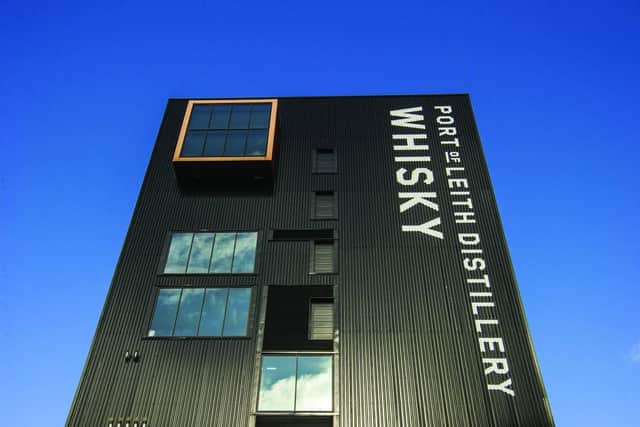Scotch whisky: What does the future hold - including new distilleries, net zero and AI


If we’re in boom times, then what does the future hold? And are we at risk of looking back at this time and reflecting on halcyon days?
The main thing that most distilleries are working towards is the Scotch Whisky Association’s targets for net-zero.
Advertisement
Hide AdAdvertisement
Hide AdDistilleries and brands are looking at things such as bottling, with Bruichladdich overhauling the design of its signature The Classic Laddie with its most innovative packaging to date, reducing CO2 emissions for the single malt’s packaging by 65 per cent by eliminating its secondary tin, and introducing a significantly lighter recycled glass, plus making reductions in water and energy consumption. Meanwhile, International Beverage Holdings, which owns Old Pulteney, Speyburn, Balmenach, Knockdhu, and Balblair, has a comprehensive plan for sustainability that focuses on three key areas – water stewardship, energy reduction, and management of co-products.


The drive to net-zero looks to be a very collaborative process within the sector. Back in July, Chivas Brothers announced that it was making its carbon-cutting heat-recovery technology “open source” – sharing with the entire industry an innovation that can cut the energy consumption during the whisky distillation process by more than half, at 53 per cent.
Jean-Etienne Gourgues, chairman and chief executive of Chivas Brothers, says:“As a business with a long history of innovation, we believe this is the right thing to do. Collaboration across our industry will be fundamental if we are to meet collective ambitions around sustainability, safeguarding the long-term future of our product, and our planet.”
New plans around sustainability can arguably be more easily implemented in new-build distilleries of which there are more and more. The Port of Leith Distillery finally opened this year, after more than a decade of planning and fundraising. The project is the brainchild of boyhood friends and distillery co-founders Patrick Fletcher and Ian Stirling, who hatched the idea –naturally enough – over a dram.
Over in the West Highlands, Nc’nean has a similar story, with founder and chief executive Annabel Thomas working hard over years to realise her dream. It’s also one of the most sustainable new distilleries in Scotland with its organic whisky, the option to go packaging-free on orders and a beautiful recycled glass bottle.
Other new distilleries coming down the line include Eden Mill’s new home, Benbecula, Portintruan Distillery on Islay, and the Machrihanish Distillery. Ghost distilleries Port Ellen and Rosebank are expected to open soon, and will join Brora in making history as the stills kick back into life and whisky is produced once again after years of being dormant.
Whisky regions too are reshaping themselves, with Campbeltown going through something of a renaissance. New entrants the Machrihanish Distillery, which broke ground in 2023, Witchburn, and Dal Riata, both of which have gained planning approval, are on their way with some more in the pipeline.
Scotland’s smallest whisky region, which was once home to almost 30 distilleries, is on the up.
Advertisement
Hide AdAdvertisement
Hide AdFife too is seeing a huge surge in whisky distilleries, and has revealed plans for a premium cask storage facility, along with bottling and additional cask services.
Innovative distillery InchDairnie, based near Glenrothes, is pushing the boundaries of creativity with their processes, releasing RyeLaw, a rye whisky, this spring, with owner Ian Palmer calling for Fife to be recognised as its own whisky region.
Artificial Intelligence (AI), something that’s being talked about more and more, is also making its mark on the whisky industry by helping influence consumer choice. University of Edinburgh Professor Drew Hemment says: “You could imagine a Netflix for whisky,” referring to how recommendations on such streaming platforms recommend other programmes and music for users, based on AI.
He adds: “In the sense of a personalised whisky service, you could log into a website, and it already knows your purchasing history, and you can maybe answer a few questions, and it is going to recommend to you some whiskies that are really suited to you that are personalised.”
Johnnie Walker used AI to personalise its Flavour Finder quiz, which is one of the first things visitors to its flagship venue on Princes Street in Edinburgh engage with.
Preferabli, a US firm, is taking this a step further and offering consumers and businesses more granular personalisation thanks to AI.
The huge growth in Scotch has paved the way for English and Welsh whiskies, who are growing in number and popularity. But instead of a competitive market, this is a collaborative one that’s filled with respect.
Speaking to The Drinks Business magazine, Dan Szor, founder and chief executive of The Cotswolds Distillery, compared the relationship between English and Scottish whisky to English sparkling wine and Champagne, saying: “Just as English fizz producers will always be compared with Champagne, we’ll always be likened to Scottish single malt.”
Advertisement
Hide AdAdvertisement
Hide AdThe late author Dr Jim Swan – referred to as the “Einstein of Whisky” – helped a good few English distilleries, and Penderyn in Wales, set up, advising on stills and casks.
Andrew Nelstrop, owner of The English Whisky Co., reflects on how Scottish techniques and talent helped launch their distillery in Norfolk, saying: “Our distilling equipment was designed, manufactured and installed by Forsyths of Scotland, who are regarded as the world’s finest Still makers. Our first distiller was Iain Henderson, who had previously run Laphroaig. He came to Norfolk to run our distillery initially and train his successor.
“Alongside this, our distillery is a traditional double-pot still set up, very similar to those found in Scotland. It is designed to make the very finest whisky and to only make whisky.”
Due to the soaring success of Scotch exports – the drink accounts for 25 per cent of all UK food and drink exports, 77 per cent of Scottish food and drink exports, and supports more than 10,000 jobs in Scotland – UK agri-food and drink attaches are working in new and emerging markets to promote whisky to what they say is a discerning but engaged audience.
Scotland and Scotch are perceived well overseas, with consumers in South East Asia having a “strong affinity with Scotch, recognising its high quality and associate it with prestige and success.”
An attache based in Vietnam reports “consumers across the region responsibly enjoy Scotch for what it is – a premium product which represents both a drink and an experience in one.”
With new releases coming out on what feels like a weekly basis, new distilleries on the horizon, and a buoyant export market, Scotch whisky is on a high. And with new technology and emerging markets, it looks set to stay that way for a while.